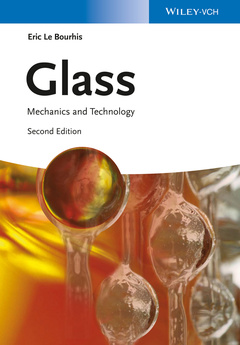Glass (2nd Ed.) Mechanics and Technology
Auteur : Le Bourhis Eric

The sections on properties include mechanical strength and contact resistance, ageing, mechanics of glass processes, the production and control of residual stresses, high-tech products, and current research and development. Applications include glazing, packaging, optical glass, glass fibers for reinforcement, and abrasive tools. The development of touchscreen technology showed how important were the design and resistance of thin flexible glass and these new thin aluminosilicate glasses are also discussed.
GLASS, A CERAMIC MATERIAL
Four Classes of Materials
Materials Properties
Selecting Materials
Performance Indexes
Shape Factors in Mechanical Design
GLASS PREHISTORY AND HISTORY
Natural Glasses
Early Glasses
First Optical Glasses
Modern Glasses
APPLICATIONS OF GLASS
Glazing
Containers
Optical Glass
Glass Fibres for Insulation and Reinforcement
Abrasive Tools
Glass Manufacturers
GLASS STRUCTURE
Introduction
Silica Glass and Related Glasses
Borate Glass and Related Glasses
Organic and Chalcogenide Glasses
Metallic Glasses
Avoiding Crystallization
Vitroceramic Fabrication
Surface Structure
GLASS RHEOLOGY
Viscosity
Glass Transition and its Observation
Viscous Response of Glass
Visco-Elastic Response of Glass
Thermal Tempering of Glass
Transient Stress
Chemical Tempering of Glass
MECHANICAL STRENGHT OF GLASS
Theoretical Strength
Tensile Resistance of Glass
Stress Concentration and Griffith Energy Balance
Linear Elasticity Crack Tip Stress Field
SIF under Non-uniform Stress
Toughness Measurement
Influence of Residual Stress on Strength and Fragmentation
Statistic Weibull Analysis
CONTACT RESISTANCE OF GLASS
Sharp and Blunt Contact
Sharp Contact Resistance
Scratch Resistance
Abrasion Resistance
Introducing a Controlled and Critical Surface Flaw
Cutting Glass
AGEING OF GLASS
Fatigue in Glass
Stress Corrosion
Charles and Hillig Theory
Life Time Under Static Fatigue
Applications
NiS Phase Transformation
Crack Healing
MECHANICS OF GLASS PROCESSES
Introduction
Float Process
Fusion Draw
Container Process
Fiber Process
PRODUCTION CONTROL OF RESIDUAL STRESSES
Introduction
Residual Stresses in Flat Glass
Basics of Photoelasticity in Flat Glass
Stress Meters
HIGH-TECH PRODUCES AND R&D
Market Trend-Driven R&D
Flat Displays
Thin-Film Technology
Residual Stresses in Thin Film
CONCLUSIONS
APPENDICES
Light Absorption and Dispersion
Atomic Structure and Bond Formation
Thermal Expansion and Elasticity
Falling Sphere Viscometer and Fining of Glass
Theoretical Strength of a Solid
Weibull Analysis in Practice
Photoelasticity Set Up for Lectures
Instrumented Nanoindentation Applied to Thin Films
Strain and Stress
Flow and Plasticity in Glass
Finite Element Analysis
X-Ray Diffraction Analysis of Thin Film Residual Stresses
Diffusion
Eric Le Bourhis is professor at Poitiers University (Futuroscope, France). He initially taught at a secondary school in Lima (Peru) between 1989 and 1991. Upon returning to France, he gained his PhD at Paris VII University in 1994. During this period, he started investigations of the thermo-mechanical properties of semiconductors. Then he joined Evry University for one year as an assistant professor and subsequently the Saint Gobain R&D team at Aubervilliers for 4 years as an engineer. During this industrial period, he applied contact mechanics to glass surfaces and coatings developed for glazing, and was also involved in industrial production tasks. He joined Poitiers University in 1998, where he has pursued an activity to promote sol-gel hybrid coatings in close collaboration with glass industrial manufacturers, while his other activities focus on small-scale mechanics.
Date de parution : 11-2014
Ouvrage de 416 p.
17.5x25.2 cm
Disponible chez l'éditeur (délai d'approvisionnement : 14 jours).
Prix indicatif 157,56 €
Ajouter au panier